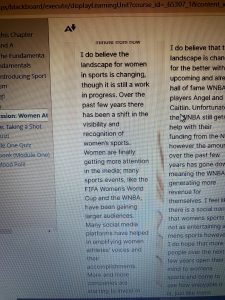1
Section One: The Fundamentals
A) What do we know about sport? What are common assumptions we make about sport and society?
Sports are more than just games and entertainment. It goes way beyond that and is connected to many things, like culture and politics. Sports also teach invaluable lessons to people, such as teamwork, discipline, and even leadership. Many different sports can bring people from around the world together and make then proud of their nation. This can also bring a lot of tension and conflict when two countries with differing views face off against each other. Some common assumptions we make about sport and society are that athletes succeed due to their unmatched talent. While some athletes are naturally drawn to specific sports and excel faster then others, this does not mean that hard work wasn’t a factor in their success. Not only hard work but money, training and support can all play big roles in contributing to an athlete’s success. Another assumption we make is that sports are all for show/entertainment and it is simply for fun. While sports are a form of entertainment, it can also reflect social issues and inspire social movements. Many times, athletes have become symbols for larger causes. Other common assumptions we make is that sports are mainly made for men. Sports have been dominated by men for many years, but women are now rising and gaining more visibility within this field. They are also receiving many more opportunities in sports. However, there are still many issues when it comes to gender and sports. Women and men are often treated different and women athlete’s receive little media attention and the pay is very different then that of male athletes.


Sports Build Character For many people, myself included, sports have indeed built character. However, more times than we think, sports can lead to feeling inadequate or having low self-esteem. I can speak from personal experience when I say that competing with other people can often lead to negative experiences. Playing soccer growing up was a very fun experience, but more often than not I was faced with severe anxiety when it came to competing with people from other schools. My coach was nice the majority of the time, but other times it seemed like winning was the only thing on her mind. Rather than building positive traits in the team, like resilience and leadership, the focus was on winning. This made many people on my team develop anxiety and low self-esteem when it came to the actual match. Instead of encouraging us to work harder, it actually had an opposite effect. We felt more pressure on us to win rather than encouraging us to enjoy the game. I’ve noticed many sports that put a lot of pressure and emphasis on their athletes to the point where the environment becomes toxic. A lot of times coaches/trainers will jeopardize the personal well-being of their athletes instead of creating a safe and positive environment. To ensure success, some coaches or even teammates may create negative spaces where they bully or favor other athletes. This builds stress and resentment rather than positive characteristics. Also, not everyone feels the same way about sports; while it may build the characteristics of one person, another might find it draining and more of a burden.
|
Exercise 3: Notebook prompt
What are some other metanarratives about sport that you are familiar with? Find an image or video clip or draw something yourself that captures this idea…
So what? Why does any of this matter? Does it matter? As something we grow up with – live with – play through – we don’t often interrogate the meanings of sport, and perhaps we don’t want to.
But being aware of these assumptions and metanarratives is especially important, I would argue, because of the centrality of sport to our everyday lives, the role that sport plays in shaping our childhood and worldviews and….. [finish that thought]
| Some other metanarratives I have heard are that sports often offer a way for people of all backgrounds (regardless of their economic background) to emerge from their circumstances and build better (more successful and wealthier) lives for themselves through sports. This narrative makes us think that anyone from any background can simply rise above their situation by working hard and having the talent to do so. This relates to the “heroism and glory” metanarrative, and gives off an “American dream” success story that many people in western society love to see and hear about.
LeBron James went from poor to wealthy. He faced many challenges in his life, but overcame everything and is now one of the most famous basketball players. But being aware of these assumptions and metanarratives are especially important, I would argue, because of the centrality of sport to our everyday lives, the role that sport plays in shaping our childhood and worldviews and our narratives can often influence our identities, values, and even our expectations of success and of failure. Whether we think about it consciously or not, the stories (metanarratives) made about sports – like the idea that it builds character – shapes how we view ourselves and others. These assumptions don’t just stop on the field and they don’t stop at just one topic. Gender, race and nationalism are also impacted. By questioning these ideas and assumptions we can better understand the ways sports impact us, both as individuals and as a society.
|
B) What is social justice?
Exercise 4: Padlet Prompt
Think back to the last section and try to look at some of the ideas we discussed differently. How might sport and social justice actually co-exist?
Record any images, video clips, or gifs you added to the padlet and identify a point of intersection between sport and social justice (can be an issue or a barrier or a debate or something you would like to explore in more depth in this course) . Screenshot or paste in your response below.
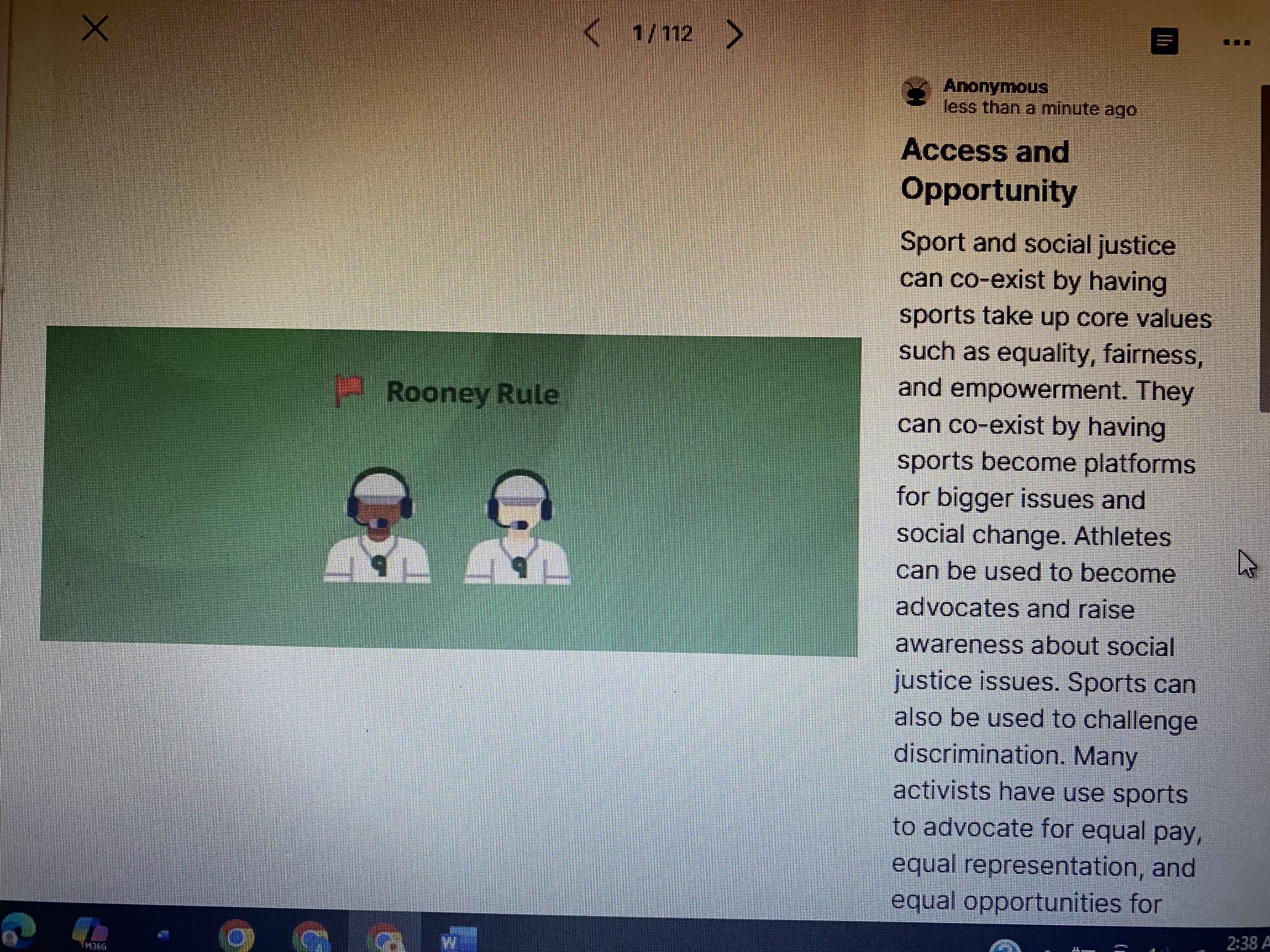
Sport and social justice can co-exist by having sports take up core values such as equality, fairness, and empowerment. They can co-exist by having sports become platforms for bigger issues and social change. Athletes can be used to become advocates and raise awareness about social justice issues. Sports can also be used to challenge discrimination. Many activists have use sports to advocate for equal pay, equal representation, and equal opportunities for Women and LGBTQ+ athletes. One point of intersection between sports and social justice in the issue of racial inequality and representation in sports. The underrepresentation of athletes of colour in leadership roles even when majority of them make up a large percentage of professional sports teams. Especially in coaching, team ownership, and management. The NFL’s “Rooney Rule” is an example of this. It mandates that teams are to interview minority candidates for the position of head coach. This was established because of the recognition that racial minorities were being excluded from these leadership positions.
|
C) Social Justice Reading

D) KINESIOLOGY AND SOCIAL JUSTICE
Exercise 5:

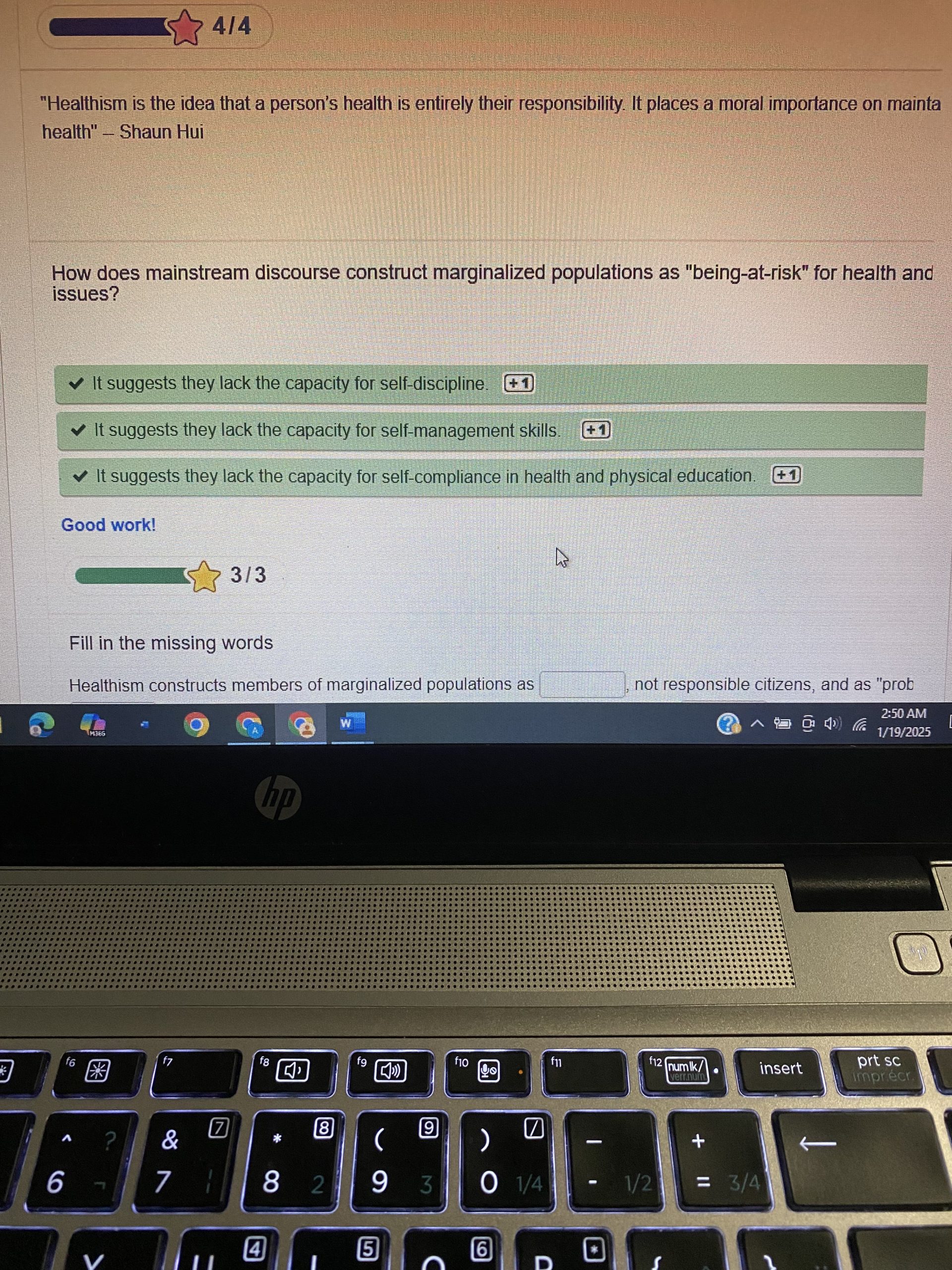
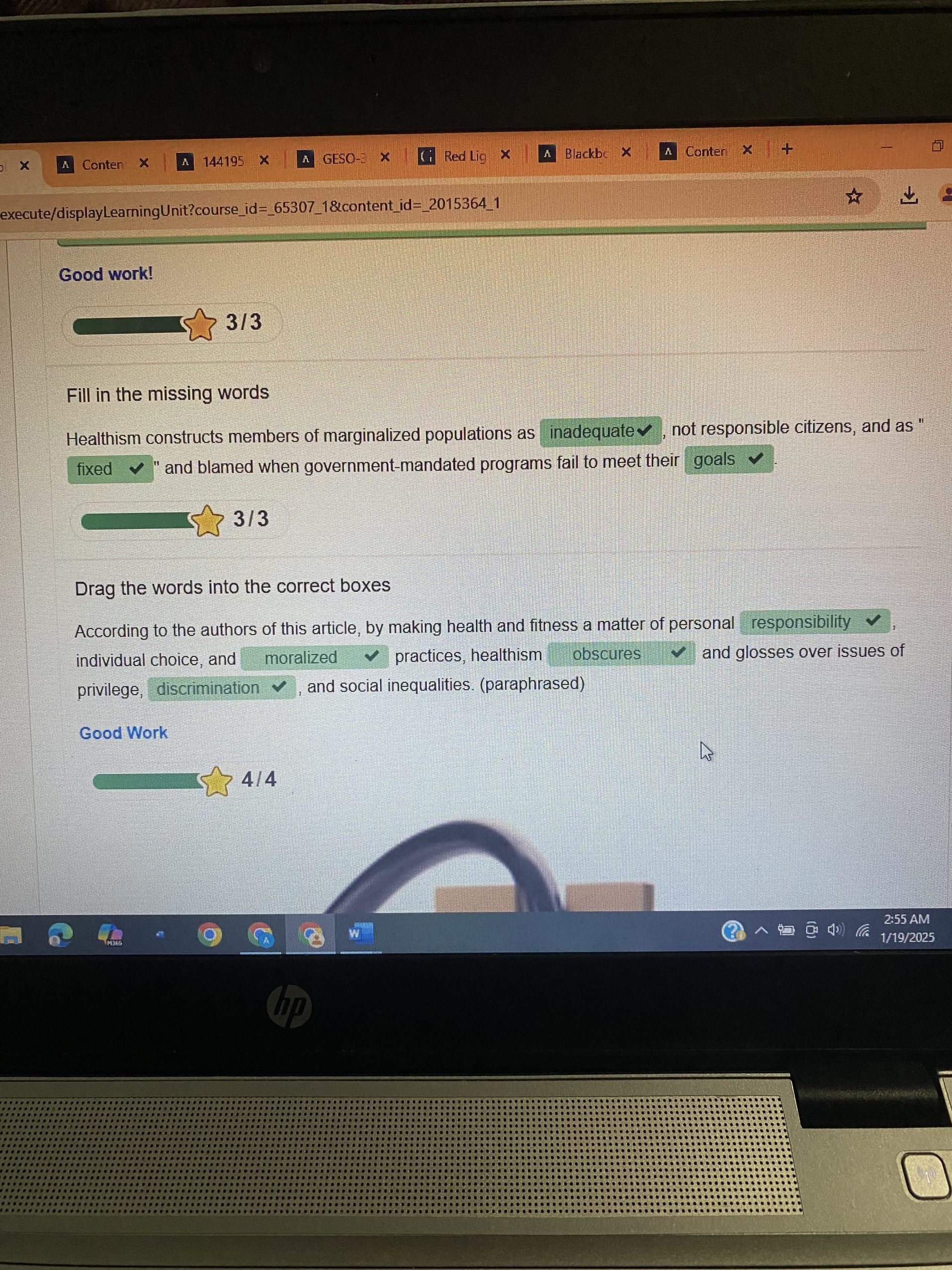
Exercise 6:
What are the implications of bodies-at-risk discourse and the refusal to understand the health gap from a social justice perspective, according to the authors of this article?
| The bodies-at-risk discourse tends to frame individuals, especially those from marginalized communities, as inherently vulnerable or responsible for their own health risks. This perspective puts light more on personal responsibility more than addressing the social, economic, and environmental factors that contribute to health disparities. By focusing simply on personal choice, this issue can reinforce stigma and put blame on people for health outcomes, which ignores the bigger picture that could include poverty, lack of access to health care, or discrimination. Refusing to understand health gaps from a social justice perspective means ignoring the real cause of health inequalities. Majority of the time these reasons include racism, poverty and lack of access to good health care. Instead of fixing these bigger issues we end up focusing more on small, individual behaviours (telling people to eat better/exercise more). Which doesn’t sole the deeper problems that affect people’s health. Another thing is the way people talk about at-risk bodies can make it seem like certain groups are unhealthier than others (people of low-income homes/people of colour). This view ignores how society and systems of power can have major effects on peoples lives that contribute to their struggles. A social justice approach would push for changes that redistribute resources and creates more equal opportunities for everyone.
|
Section Two: Sport Feminism
Exercise 7: Notebook Prompt
What is feminism? What does it mean to you? Choose one of the images below and explain how it captures your understanding of feminism (or find one that does speak to you and paste this into your pressbook with an explanation of why it matters to you.

| Feminism is the belief that all people, no matter what their gender may be, should have equal rights and opportunities. Feminism is essentially a fight against unjust treatment towards people based on their gender and makes sure that everyone has a fair chance in life. To me, feminism is a way for everyone (regardless of gender) to be treated with respect. This also means that everyone can live freely without feeling like they are being held back by society. It’s about fighting back against all types of gender-based mistreatment. The image of a man wearing a shirt that reads “this is what a feminist looks like” immediately stood out to me. It captures an important aspect of feminism, which is that feminists are not only women. Feminism is not about gender; it’s about advocating for equality and standing up against gender-based injustice. By wearing that shirt, the man in the image is demonstrating that anyone, regardless of their gender, can support and work towards a better future that encompasses equality. It also shows that everyone has a role in fighting for a better, fairer world. Feminism is about a collective effort, requiring the support and participation of everyone. When men fight for feminism, it can help break down many harmful stereotypes and expectations that are held on both men and women. It can help challenge toxic masculinity, and help people to not be pressured into conforming to gender stereotypes. By helping and being allies in the fight for equality, men can help in creating a safer, more just and balanced society.
|
Exercise 8: Notes Prompt (optional)
What are the different kinds of feminism the authors outline and how do they connect to sport?
In the article “Gender, Feminist Theory and Sport” by Scraton, Sheila, and Anne Flintoff the different kinds of feminism outlined are Liberal Feminism, Radical Feminism, Socialist Feminism, poststructuralist feminism (added), and postcolonial feminism (added). Liberal feminism is the type of feminism to focus on equality of opportunity and individual rights. In sport this means that women athletes should be able to have the same opportunities as male athletes. They should be able to have equal access to facilities, competitions, and pay. Radical feminism is a type of feminism that believes that sports are set up to have women fail and favour men. This type of feminism talks about how sports culture is male dominated and that women should be able to have their own space. Socialist feminism is the type of feminism that looks at gender and class. In sport, it says that money-driven systems affect women’s sports by giving them less attention, fewer resources and less pay. This form of feminism addresses both gender and economic inequalities. Even though the authors primarily speak about these three types of feminism, I would like to add two more that I have found through research and how they connect to sports. Poststructuralist feminism is the type of feminism that focuses on how society creates gender roles. In sports, there is a fixation on the idea that men are strong and aggressive and women are weaker and more graceful. This type of feminism believes that gender is not fixed, rather it should challenge the traditional roles of male and female in sport. Postcolonial feminism looks more are history and how it has affected women in sports (especially POC women). It reflects the power imbalances in sport between races and it pushes for more recognition of these different cultures and backgrounds in sports.
Exercise 9: Crossword Activity

Exercise 10: Padlet Prompt
| THESE ARE THE WORDS I USED
Women Black Feminism Marxist Queer Gender Feminist Theory Radical Liberal Socialist Understanding Equality Sexism Social Justice Oppression Representation Sexism Inequality Discrimination Empowerment Intersectionality Sports Culture Masculinity Inclusivity Accessibility Competitiveness Diversity Athlete Wage Gender Roles Bias Advocacy Stereotypes Agency Activism Exclusion Resilience Sexualization Marginalization Power Race
|
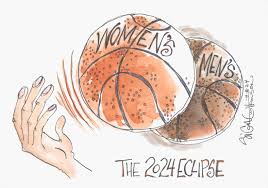
| I do believe the landscape for women in sports is changing, though it is still a work in progress. Over the past few years there has been a shift in the visibility and recognition of women’s sports. Women are finally getting more attention in the media; many sports events, like the FIFA Women’s World Cup and the WNBA, have been gaining larger audiences. Many social media platforms have helped in amplifying women athletes’ voices and their accomplishments. More and more companies are starting to invest in women’s sports and are investing in more advertisements and sponsorships for them. As for if people still care about women’s sports, I believe they do. In fact, I think they care more than they did in the past. The fanbase around women’s sports has visibly grown over the past couple of years. Before stereotypes about women’s sports stopped people from enjoying watching women’s sporting events. Now, however, a lot of people are discovering the talents and skills in women’s leagues.
|



